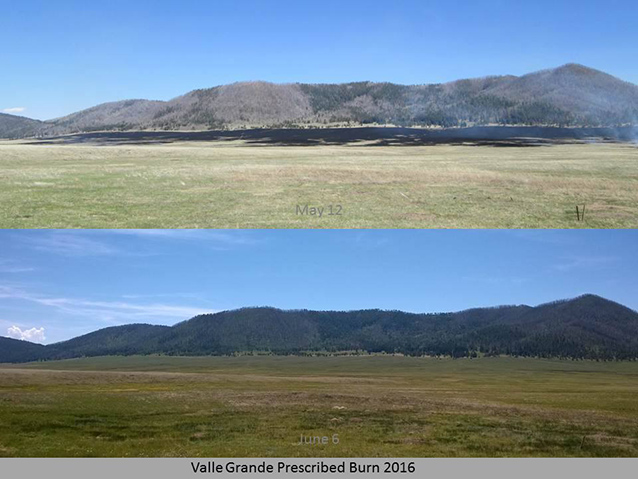On May 11 and 12, 2016, the National Park Service (NPS) fire staff, along with many interagency partners, was able to successfully implement a prescribed fire in the Valle Grande of the Valles Caldera National Preserve. The blackened Valle Grande will turn a rich green with the late spring moisture and will attract wildlife, especially elk.
Objectives

NPS
The objectives of the prescribed fire were to provide for firefighter and public safety first, reintroduce fire back into a fire adapted ecosystem, and reduce fuel loadings during prescribed environmental conditions to allow for moderated fire effects. Fire managers were able to burn close to 1,250 acres of the 1,471 acre treatment unit. Stewart Robertson, acting assistant fire management officer, stated “The timing of the prescribed fire in the Valle Grande could not have been better.” Robertson commented “We, along with other agencies conducting prescribed fires at the same time, took advantage of a tight weather window to implement this burn. Winds, relative humidity, temperatures, available resources, and green-up timing were all perfect.”
Ecological Benefits

NPS
The ecological benefits of this prescribed fire will be apparent right away. Fire is a natural and vital component on this landscape. The processes of fire are important in many ways as many plant species are dependent on fire to reproduce. Fire also releases important nutrients back into the soil (e.g., calcium, phosphorus, iron, magnesium, etc.) back into the ecosystem to promote robust vegetative growth, which deer and elk will capitalize on. Dr. Bob Parmenter adds “By burning off the thatch, the soil is exposed to sunlight and warms up more than it would if it were shaded by dead grass litter, which in turn speeds up root growth and eventually plant growth.” “We are working to restore conditions in the preserve that will allow us to safely bring back the historic fire regime in a way that enhances biodiversity and wildlife habitat, improves watershed function, and reduces the potential for high severity fires like we saw in the 2011 Las Conchas fire,” said Valles Caldera National Preserve Superintendent Jorge Silva-Bañuelos. "The Valle Grande prescribed burn is a great example of how this can be done successfully and safely," he continued.

NPS
Interagency Partnerships

NPS
The implementation of the prescribed fire in the Valles Caldera would not have been successful without assistance from our local interagency partners. The fire organization consisted of wildland engines and staff from the NPS, USDA Forest Service – Jemez Ranger District, Santa Fe County, La Cueva Volunteer Fire Department, and Los Alamos National Laboratory (LANL).
Manny L’Esperance, LANL Wildland Fire Program Manager stated “The LANL Wildland Division was fully engaged in every aspect of planning and implementation of the prescribed fire. We had resources on-scene, fully supported the operation, and appreciated the opportunity to interact and maintain the positive working relationship we share with the NPS.” Regarding interagency cooperation Robertson states, “It is important for local resources to work together and maintain those high levels of trust and competence for those times when we need to act decisively when suppressing wildfires. Some wildfires require quick action to control, so having relationships already established leads to enhanced productivity.”
Planning For The Future

NPS
The National Park Service now has the responsibility of managing fire on the Valles Caldera National Preserve. Fire Management Officer Marla Rodgers states “We will continue to look for similar opportunities to conduct prescribed fire both in the valles, as well as, in select locations throughout the preserve in an effort to maintain fire on the landscape for both ecological benefits and to reduce hazardous fuel accumulations.” The Valles Caldera National Preserve will now look at writing prescribed fire plans and implementing burns in other blocks within the Valle Grande.
Last updated: June 2, 2016
